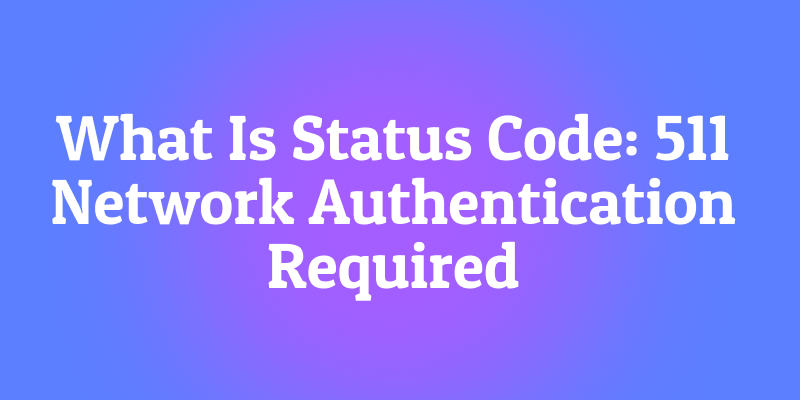You've probably experienced this before: you settle into a hotel room or airport lounge, connect to the Wi-Fi, and open your browser to check your email. But instead of seeing Google, you’re redirected to a page asking you to accept terms, watch an ad, or enter your room number.
That page—and the redirect behind it—comes from one of HTTP's most practical and user-friendly status codes: 511 Network Authentication Required.
Unlike error codes that signal something is broken, the 511 status code actually helps you. It's the network's polite way of saying, "Hold on! Before you can browse the internet, please complete this quick step." This mechanism powers what's known as a captive portal—the login or agreement page that appears before you can use free Wi-Fi.
It's important to note that this isn't a server-side error; it's a network-level authentication issue. You've likely seen it at airports, cafés, or hotels—anywhere that public Wi-Fi requires you to log in or accept terms first. That's 511 at work.
In short, the 511 status code is the hidden technology that allows places like hotels and airports to control Wi-Fi access smoothly and securely.
Before we dive into what it means, when it appears, and how to resolve it, here's a quick tip for developers who work with APIs or network requests regularly:
Alright, let's explore and make sense of this mysterious yet important status code: the 511 Network Authentication Required.
The Problem: Managing Public Network Access
To understand why 511 exists, we need to consider the challenges of providing public WiFi:
- Access Control: How do you prevent just anyone from using your network?
- Terms of Service: How do you ensure users agree to your usage policies?
- Monetization: How do you show ads or collect payment for premium access?
- Bandwidth Management: How do you control network usage and prevent abuse?
The traditional solution was complicated: users would connect to WiFi but couldn't figure out why nothing worked. The 511 status code provides an elegant, standardized solution to this problem.
What Does HTTP 511 Network Authentication Required Actually Mean?
The 511 Network Authentication Required status code indicates that the client needs to authenticate to gain network access. It's typically used by captive portals that require user interaction (like clicking a button, watching an ad, or entering credentials) before granting full internet access.
The key insight is that 511 doesn't come from a web server hosting the content you want it comes from a network-level intermediary that's controlling access to the entire network.
A proper 511 response should include instructions for the client on how to authenticate. While there's no single standardized header for this (like WWW-Authenticate for 401), it typically includes an HTML page with the authentication portal.
Here's what a 511 response might look like:
HTTP/1.1 511 Network Authentication RequiredContent-Type: text/html
<html><head><title>Network Authentication Required</title></head><body><h1>Welcome to Airport WiFi</h1><p>Please <a href="/login">click here</a> to access the internet.</p></body></html>
This status code is defined in RFC 6585, which extends the HTTP/1.1 protocol to include new status codes for better error reporting.
Here's the official definition:
"The 511 status code indicates that the client needs to authenticate to gain network access."
Real-world analogy:
Imagine you walk into a members-only gym. You see all the equipment, but before using anything, you need to check in at the front desk. The receptionist verifies your membership, and only then can you start your workout.
That's what 511 does. It's your network's "front desk".
What Causes the 511 Status Code?
Now that we know where it shows up, let's understand why.
A 511 Network Authentication Required usually occurs when:
- The network gateway or proxy intercepts traffic and checks whether the user is authenticated.
- The user's device tries to access an external resource (like a website or API) without valid authentication.
- The gateway refuses to forward the request to the intended destination until the authentication step is completed.
In technical terms, it's not the web server (like example.com) that sends this status. It's your network gateway or proxy sitting in between.
Common Scenarios Where You'll Encounter 511
Let's explore where this happens most often and why.
1. Public Wi-Fi Networks
This is by far the most common cause.
When you connect to a hotel, airport, or café Wi-Fi, your network often redirects your traffic to a login or terms page.
If you try to visit a normal website before authenticating, the captive portal intercepts the request and returns a 511 Network Authentication Required response.
2. Corporate or School Networks
Enterprises and universities often secure their networks with authentication systems.
If you connect a new device or if your session token expires, your access may be restricted leading to a 511 until you re-authenticate.
3. Proxy or Firewall Authentication
Some organizations route internet traffic through proxies or firewalls that require credentials. If the proxy fails to authenticate your session, your browser might show a 511 response.
4. VPN Gateway Authentication
In some VPN setups, the gateway requires users to log in or verify credentials before tunneling requests. A failed or expired token could result in a 511 error.
5. IoT and Device Control Networks
IoT devices that connect through managed networks (like smart TVs in hotels) may trigger this error if they can’t automatically authenticate with the network.
How Captive Portals Work: The Magic Behind 511
Let's walk through what happens when you connect to a WiFi network with a captive portal.
Step 1: The Connection
You select "Airport_Free_WiFi" from your available networks and connect. Your device gets an IP address via DHCP.
Step 2: The First Request
You open your browser and try to visit https://www.google.com. Your device sends the request out to the network.
Step 3: The Interception
The network gateway (running the captive portal software) intercepts your request. Instead of letting it through to Google, it responds with a 511 Network Authentication Required status code and serves the login/splash page.
Step 4: The Authentication
You see the airport's welcome page. You might need to:
- Click "I Agree" to accept terms of service
- Watch a 30-second advertisement
- Enter a password or room number
- Purchase access with a credit card
Step 5: Access Granted
Once you complete the authentication, the captive portal adds your device's MAC address to an allowed list and redirects you to your original destination (or a success page).
Step 6: Normal Browsing
Now when you try to visit Google, your request passes through unimpeded, and you receive a normal 200 OK response with the search page.
511 vs. Other Authentication Codes: Knowing the Difference
It's important to understand how 511 differs from other authentication-related status codes.
511 vs. 401 Unauthorized:
401comes from a specific website and means "I won't show you this page until you log in."511comes from the network infrastructure and means "I won't let you access ANY website until you authenticate with the network."
511 vs. 407 Proxy Authentication Required:
407is about authenticating with a proxy server that's forwarding your requests.511is about authenticating with the entire network before any requests can be forwarded.
511 vs. 3xx Redirects:
- Some captive portals use
302 Foundredirects instead of511. However,511is more semantic and explicit about what's happening.
The Simple Analogy:
401: A specific club within a city asking for your membership card407: The city gate asking for your entry permit511: The entire city asking you to register at the visitor center before entering any buildings
Testing & Building APIs with Apidog

For developers, dealing with captive portals presents unique challenges. Your application needs to detect when it's behind a captive portal and guide users appropriately. Apidog can help you test these scenarios.
With Apidog, you can:
- Simulate Captive Portal Responses: Create mock endpoints that return
511status codes with various authentication page designs. - Test Application Behavior: Verify that your app correctly detects
511responses and provides helpful guidance to users instead of showing generic error messages. - Handle Redirects: Test how your application handles the transition from captive portal to normal operation.
- Check Offline Functionality: Ensure your app degrades gracefully when network access is limited or requires authentication.
- Automate Testing: Create test suites that simulate the entire captive portal flow, from initial connection to full access.
This is particularly important for mobile apps, IoT devices, and any application that needs to work reliably in various network environments.
How to Fix a 511 Network Authentication Required Error
Good news: fixing this error is typically easy, though the steps depend on whether you’re a user or a developer/network admin.
For Regular Users
If you’re browsing and suddenly hit this message, try the following:
- Open a New Tab and Visit a Non-HTTPS Website: Sometimes HTTPS requests get blocked before redirection happens. Try opening
http://example.comit often triggers the captive login page. - Reconnect to the Wi-Fi Network: Forget the network and reconnect. This usually forces the login portal to reappear.
- Accept the Terms or Log In: Complete the authentication process on the captive portal.
- Disable VPN or Custom DNS: These can interfere with network authentication pages.
- Clear Cache and Cookies: Old session data might block re-authentication.
- Restart Your Device: Sometimes network stack resets fix temporary 511 loops.
For Developers or Network Admins
If you manage the network or API gateway, here's what to check:
- Inspect Captive Portal Configuration: Ensure it correctly intercepts unauthenticated requests and returns a proper login form.
- Check Firewall Rules: Firewalls should redirect unauthenticated requests to the right gateway IP or login portal.
- Review HTTP Headers: Include proper
WWW-Authenticateheaders and avoid misusing 401 or 403 in place of 511. - Whitelist Critical Endpoints: Allow authentication servers or DNS resolution even before authentication (to prevent deadlocks).
- Use Apidog for API Testing: If your APIs interact with authenticated networks, use Apidog to simulate requests, validate headers, and see when 511 responses are triggered. With Apidog, you can inspect the request path, headers, cookies, and even redirect chains to pinpoint where the authentication requirement occurs.
Best Practices for Handling 511
For Network Operators:
- Provide Clear Instructions: Make sure your
511response page clearly explains what users need to do to gain access. - Keep it Simple: The authentication process should be quick and straightforward.
- Support Multiple Devices: Remember that users may need to authenticate multiple devices.
- Respect Privacy: Be transparent about what data you're collecting and why.
For Application Developers:
- Detect Captive Portals: Implement logic to detect when your app is behind a captive portal. You can do this by making a request to a known endpoint and checking for
511responses or unexpected redirects. - Provide User Guidance: If you detect a captive portal, inform the user and guide them to complete the authentication process.
- Handle Gracefully: Don't treat
511as an error treat it as a normal part of network connectivity that requires user action. - Test Offline Functionality: Ensure your app can still provide basic functionality even when network access is restricted.
Preventing 511 in Your Environment
Here’s how to ensure 511 doesn’t disrupt your users or API consumers.
1. Maintain Captive Portals Properly
Ensure your authentication system redirects users correctly. Misconfigured portals can trap users in a 511 loop.
2. Use Clear Redirects
After login, users should be redirected back to their original destination not just a generic success page.
3. Implement Session Expiry Notifications
Notify users before their network session expires to avoid sudden 511 disconnections.
4. Log and Monitor 511 Events
Track how often 511 errors occur in your access logs. Frequent errors could mean users are struggling with login flow.
5. Test with Apidog Regularly
Before deploying network updates, simulate real user traffic using Apidog’s testing suite. This ensures network authentication triggers only when intended.
Technical Implementation Details
From a technical perspective, captive portals typically work by:
- DNS Redirection: Intercepting DNS queries and returning the IP address of the captive portal server.
- HTTP/HTTPS Interception: Using deep packet inspection or transparent proxies to intercept web requests.
- Firewall Rules: Blocking all traffic except to the captive portal server until authentication is complete.
- MAC Address Filtering: Maintaining a list of authenticated devices based on their MAC addresses.
The 511 status code provides a standardized way for the network to communicate what's happening, making it easier for clients (especially automated ones) to understand and respond appropriately.
The User Experience Perspective
While captive portals can be frustrating, the 511 status code actually improves the experience by providing a clear, standardized way to handle network authentication. Before 511 was standardized, different networks used various methods (redirects, DNS hijacking, etc.) that often confused users and broke applications.
Now, well-behaved clients can:
- Detect when they're behind a captive portal
- Automatically open a browser window to complete authentication
- Provide clear status information to users
- Resume normal operation once authentication is complete
Why 511 Matters in Modern Networking
You might be thinking, “511 is pretty rare why should I care?”
Here’s why it still matters:
- Public networks are everywhere, hotels, airports, universities, and coworking spaces all use captive portals.
- Corporate networks are tightening security, requiring authentication for every connected device.
- APIs and microservices in zero-trust environments often require token-based access that mimics the 511-style behavior.
So, understanding this code helps both developers and IT professionals handle network access challenges gracefully.
Summary: Key Takeaways
If you’ve skimmed down here for the highlights (no judgment), here’s a quick recap:
| Aspect | Explanation |
|---|---|
| Code Name | HTTP 511 Network Authentication Required |
| Definition | The client must authenticate with the network before accessing the internet or server. |
| Common Causes | Captive portals, proxy servers, firewalls, expired sessions. |
| Fix (User) | Log in to the network, reconnect Wi-Fi, disable VPN. |
| Fix (Developer/Admin) | Configure authentication redirects correctly, use Apidog for testing. |
| RFC Reference | RFC 6585 (HTTP/1.1 Additional Status Codes) |
Conclusion: 511 Isn’t an Error, It’s a Checkpoint
The HTTP 511 Network Authentication Required status code represents an important evolution in how we manage public network access. It turns what could be a frustrating technical hurdle into a smooth, user-friendly experience.
By providing a standardized way for networks to request authentication, 511 helps ensure that users can easily access WiFi in hotels, airports, cafes, and other public spaces. For developers, understanding and properly handling 511 responses is crucial for building applications that work reliably across all network environments.
So the next time you're asked to "click to connect" on a public WiFi network, remember that you're experiencing the 511 status code in action a small but important piece of technology that makes our connected world work more smoothly. And when you're building applications that need to navigate these network challenges, a comprehensive tool like Apidog will help you ensure your software provides a seamless experience, no matter what network environment your users are in.



